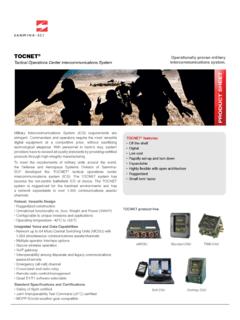Transcription of PCB FABRICATION - Sanmina
1 PCB FABRICATION Phenolic-cured materials can withstand the Substituting Dicy-cured FR-4 Materials with Phenolic-cured Materials increased temperatures of lead-free processes. But how do they effect performance? Dicy-cured FR-4 materials have been used for decades to mount electrical components to printed circuit Considerations for lead free: boards (PCBs). Traditionally composed of woven- Traditional FR-4 materials decompose in the higher processing glass reinforcement materials and an epoxy resin with temperatures needed for lead-free solder a dicyandiamide (dicy) cure agent, dicy-cured FR-4 The altered resin content of phenolic-cured materials may impact materials are commonly used in processes that utilize signal propagation delays and noise margins Tin-Lead-based solder such as automated-wave, hot- air or hand-soldering assembly techniques.
2 However, the industry faces new environmental regulations that require a significant reduction in or elimination of the Tin-Lead solder used in electronic assembly, a mandate to create what are commonly termed lead-free or RoHS-compliant electronic assemblies. Lead-free Electronic Assemblies Producing lead-free assemblies require higher reflow temperatures for both assembly and rework, and temperatures greater than what dicy-cured FR-4. materials can withstand. (Dicy-cured FR-4 materials begin to decompose at temperatures near 260 C, well within the typical temperature range of lead-free assembly processes.). Reflow temperature profiles A new generation of lead-free compatible materials have been developed that apply added fillers and alternative cure agents to improve their thermal robustness. These materials, known as phenolic-cured FR-4, use phenol compounds to increase their thermal performance.
3 However, while modifying the resin components and cure agents increase thermal performance, it can also potentially effect the process capability and electric properties of PCBs. Recognizing these potential effects, Sanmina -SCI . began investigating the relationship between phe- nolic-cured FR-4 materials and process capability, and electrical properties. The investigation began with basic research into material properties such as measuring the coefficient of thermal expansion (CTE) and time to delamination (T260). It then proceeded to in-depth short and long-term reliabil- ity tests. The short-term reliability tests, consisting of thermal shock tests (multiple solder float tests), focused on typical post-PCB processes such as Thermal cycle data assembly and rework. The long-term reliability tests, which consisted of thermal cyclic tests (gas phase thermal cycle tests and IST), focused on the lifetime capability of the PCB.
4 The investigation revealed that most phenolic- cured materials observe a higher dielectric con- stant (Dk) than dicy-cured materials, demonstrat- ing an average increase of 7 percent in dielectric constant for a resin content of 50 percent. (This ratio will change as resin percentages change.). Furthermore, most phenolic-cured materials observe a wider variation in Dk from supplier to supplier, and even from product to product made Dk for Dicy and phenolic materials by the same supplier. To compensate for this higher dielectric constant, PCB manufacturers may need to modify trace widths or dielectric spacing on PCBs. Because these modifications may impact signal-propaga- tion delays or noise margins, PCB manufacturers should also perform system-level testing and simulation to determine their impact. Test frequency (MHz). As one of the world's largest manufacturers of high-technology PCBs, Sanmina -SCI has significant experience designing and manufacturing boards using industry-leading technologies.
5 We offer these technologies in each of our FABRICATION sites worldwide and provide design for manufacturability (DFM). support for our customers in pre-design and layout phases to ensure the smooth integration of new and 2700 North First Street cost-saving technologies to the production process. San Jose, California 95134. Phone: +1 408 964 3555. Fax: +1 408 964 3636. About Sanmina -SCI. Sanmina -SCI Corporation is a leading electronics contract manufacturer serving the fastest-growing segments Europe & Middle East of the global Electronics Manufacturing Services (EMS) market. Recognized as a technology leader, Sanmina -SCI +49 711 7287 220. provides end-to-end manufacturing solutions, delivering unsurpassed quality and support to OEMs primarily in the communications, defense and aerospace, industrial and semiconductor systems, medical instrumentation, multimedia, Asia Pacific enterprise computing and storage, and automotive technology sectors.
6 Sanmina -SCI has facilities strategically located +65 62457300. in key regions throughout the world. More information regarding the company is available at For more information, please visit our website at or send an email to 2009 Sanmina -SCI Corporation, printed in Sanmina -SCI is a trademark or registered trademark in the and/or other jurisdictions of Sanmina -SCI Corporation. All trademarks and registered trademarks are the property of their respective owners. 0409.



